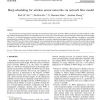Free Online Productivity Tools
i2Speak
i2Symbol
i2OCR
iTex2Img
iWeb2Print
iWeb2Shot
i2Type
iPdf2Split
iPdf2Merge
i2Bopomofo
i2Arabic
i2Style
i2Image
i2PDF
iLatex2Rtf
Sci2ools
171
Voted
COMCOM
2006
2006
Sleep scheduling for wireless sensor networks via network flow model
The pervasiveness and operational autonomy of mesh-based wireless sensor networks (WSNs) make them an ideal candidate in offering sustained monitoring functions at reasonable cost over a wide area. There has been a general consensus within the research community that it is of critical importance to jointly optimize protocol sublayers in order to devise energy-efficient, cost-effective, and reliable communication strategies for WSNs. This paper proposes a cross-layer organizational approach based on sleep scheduling, called SenseSleep Trees (SS-Trees), that aims to harmonize the various engineering issues and provides a method to increase the monitoring coverage and the operational lifetime of mesh-based WSNs engaged in wide-area surveillance applications. An integer linear programming (ILP) formulation based on network flow model is provided to determine the optimal SS-Tree structures for achieving such design goals.
COMCOM 2006 | Cross-layer Organizational Approach | Mesh-based Wireless Sensor | Reliable Communication Strategies |
Related Content
| Added | 11 Dec 2010 |
| Updated | 11 Dec 2010 |
| Type | Journal |
| Year | 2006 |
| Where | COMCOM |
| Authors | Rick W. Ha, Pin-Han Ho, Sherman X. Shen, Junshan Zhang |
Comments (0)

